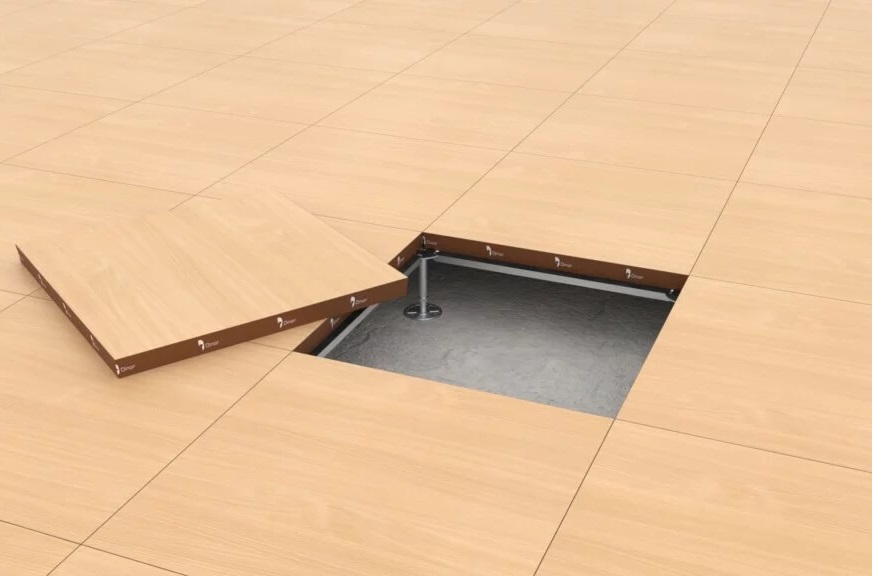- Home
- Raised Flooring
Raised Flooring – The Versatile And Cost-Effective Solution For Modern Spaces
Raised flooring is an innovative solution that has been gaining popularity in recent years. It consists of a series of modular panels that are elevated above a concrete subfloor, creating a space underneath for easy access to utilities, such as electrical and mechanical systems, cabling, and plumbing. Raised flooring is a versatile and cost-effective solution for modern spaces, offering numerous benefits that make it a popular choice for a variety of applications.
One of the main advantages of raised flooring is its flexibility. With a wide range of panel sizes, materials, and finishes available, raised flooring can be customized to fit virtually any space and design requirement. Additionally, raised flooring is easy to reconfigure and adapt to changing needs, making it an ideal solution for dynamic environments like office buildings, data centers, and laboratories.
Another key advantage of raised flooring is its accessibility. By creating a space underneath the floor, raised flooring allows for easy access to utilities for maintenance, repairs, and upgrades. This eliminates the need for disruptive and time-consuming demolition and reconstruction, saving time and money in the long run.
Finally, raised flooring is a cost-effective solution that can help reduce construction costs and improve energy efficiency. By creating a space for air circulation, raised flooring can help regulate temperatures and reduce the need for HVAC systems. This can lead to significant cost savings over time.
Improve Your Building’s Airflow And Accessibility With Raised Flooring Systems

Raised flooring systems offer numerous benefits beyond simply providing a space for easy access to utilities. One of the most significant advantages of raised flooring is its ability to improve a building’s airflow and accessibility.
By creating a space underneath the floor, raised flooring allows for improved airflow and ventilation. This is especially important in buildings that rely on HVAC systems for climate control. By creating a space for air circulation, raised flooring can help regulate temperatures and improve indoor air quality. This can have a positive impact on the health and well-being of building occupants, while also reducing the energy costs associated with HVAC systems. In addition to improving airflow, raised flooring also enhances accessibility. By providing easy access to utilities, raised flooring allows for quick and efficient maintenance and repairs. This can help minimize downtime and reduce the risk of disruptions to building operations.
Furthermore, raised flooring systems can improve the overall accessibility of a building for people with disabilities. By creating a level surface that is easy to navigate, raised flooring can provide improved mobility and accessibility for wheelchair users and other individuals with mobility impairments.
Benefits Of Raised Flooring
Raised flooring systems offer a variety of benefits for modern buildings. These include:
Easy Access to Utilities: Raised flooring provides a space underneath the floor surface that can be used for running and concealing utilities such as electrical wiring, data cabling, and HVAC ductwork. This allows for easy access to these systems for maintenance and repairs without the need for invasive and disruptive construction.
Improved Airflow and Ventilation: Raised flooring can help improve a building’s airflow and ventilation by creating a space for air circulation underneath the floor. This can help regulate temperatures and improve indoor air quality, which can have a positive impact on the health and well-being of building occupants.
Enhanced Flexibility and Adaptability: Raised flooring systems are versatile and adaptable, making them an ideal solution for modern, dynamic spaces. The floor panels can be easily removed and repositioned, allowing for quick and easy modifications to accommodate changes in layout or building systems.
Cost-Effective: Raised flooring can be a cost-effective solution for modern buildings, as it allows for easy access to utilities and reduces the need for invasive construction work. It can also help reduce energy costs by improving airflow and ventilation.Improved Aesthetics: Raised flooring can enhance the appearance of a space by concealing unsightly utilities and providing a uniform surface. It also allows for a wide range of finishes and materials to be used on the floor surface, providing greater design flexibility.

Why Choose Us?
Raised flooring systems offer a range of benefits that make them a popular choice for modern buildings. Here are some of the top reasons to choose raised flooring:
- Accessibility: Raised flooring allows for easy access to underfloor systems such as cabling, HVAC, and plumbing. This means that maintenance and upgrades can be performed quickly and efficiently without the need for costly and time-consuming demolition work.
- Flexibility: Raised flooring is highly modular and can be easily reconfigured or expanded as needed. This allows for greater flexibility in the use of the space and can help to future-proof the building.
- Airflow: Raised flooring can improve the airflow in a building by allowing air to circulate beneath the floor. This can lead to better indoor air quality and can also improve energy efficiency by reducing the load on HVAC systems.
- Aesthetics: Raised flooring systems offer a clean, modern look that can enhance the overall design of a space. They also allow for greater flexibility in design, as floor panels can be easily replaced or swapped out for different materials or colors.
- Durability: Raised flooring systems are designed to be durable and long-lasting. They can withstand heavy foot traffic, equipment, and other wear and tear, making them a good choice for high-use areas.
Frequently Asked Questions (FAQ)
Raised flooring is a modular flooring system that elevates the floor surface above the subfloor, creating a cavity or void space beneath the floor.
Raised flooring offers a range of benefits, including easy accessibility to underfloor systems, flexibility in use and design, improved airflow and indoor air quality, and durability.
Raised flooring is well-suited for modern commercial buildings such as data centers, offices, and healthcare facilities, as well as educational and government buildings.
Yes, raised flooring can be installed in existing buildings. However, the installation process may be more complex and costly compared to installing in a new building.
Raised flooring can be an environmentally friendly choice, as it can be made from sustainable materials and can improve energy efficiency by allowing for better airflow and reducing the load on HVAC systems.
Choosing the right type of raised flooring will depend on a range of factors, including the intended use of the space, the load requirements, and the desired aesthetic and design. It is recommended to consult with a professional flooring contractor to help determine the best type of raised flooring for your specific needs.


